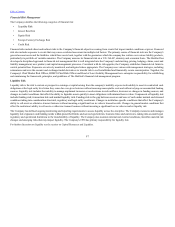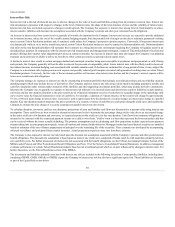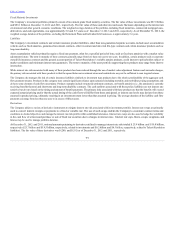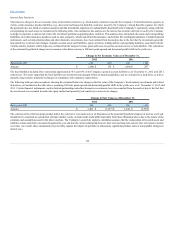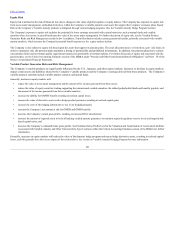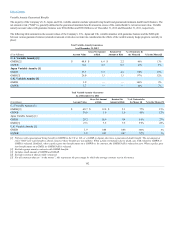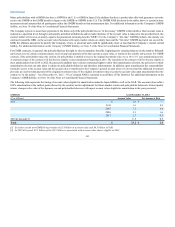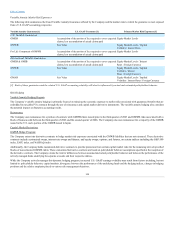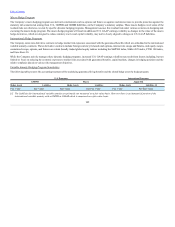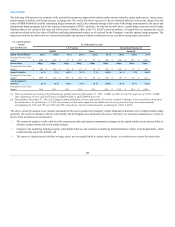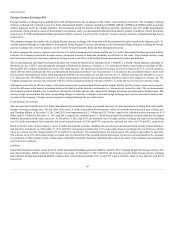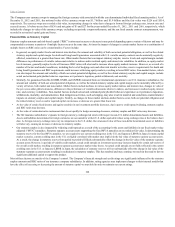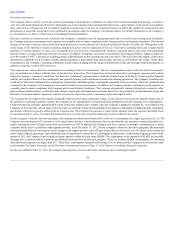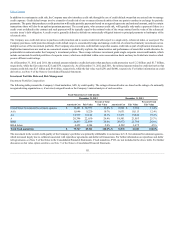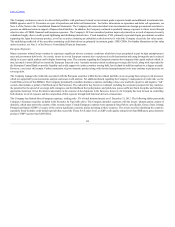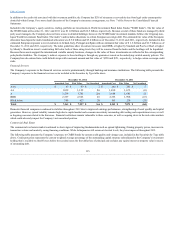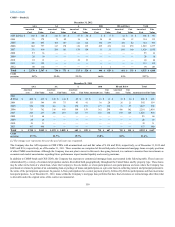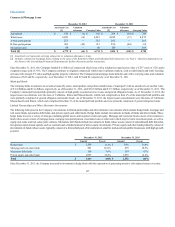The Hartford 2012 Annual Report Download - page 108
Download and view the complete annual report
Please find page 108 of the 2012 The Hartford annual report below. You can navigate through the pages in the report by either clicking on the pages listed below, or by using the keyword search tool below to find specific information within the annual report.
Table of Contents
Foreign Currency Exchange Risk
Foreign currency exchange risk is defined as the risk of financial loss due to changes in the relative value between currencies. The Company’s foreign
currency exchange risk is related to non-U.S. dollar denominated liability contracts, including its GMDB, GMAB, GMWB and GMIB benefits associated
with its Japanese and U.K. variable annuities, the investment in and net income of the Japanese and U.K. operations, non-U.S. dollar denominated
investments, which primarily consist of fixed maturity investments, and a yen denominated individual fixed annuity product. In addition, Talcott Resolution
issued non-U.S. dollar denominated funding agreement liability contracts. A portion of the Company’s foreign currency exposure is mitigated through the use
of derivatives.
The company manages the market risk, including foreign currency exchange risk, associated with the guaranteed benefits related to the Japanese and U.K.
variable annuities through its comprehensive International Hedge Program. For more information on the International Hedge Program, including the foreign
currency exchange risk sensitivity analysis, see the Variable Product Guarantee Risks and Risk Management section.
In order to manage the currency exposure related to non-U.S. dollar denominated investments and the non-U.S. dollar denominated funding agreement liability
contracts, the Company entered into foreign currency swaps and forwards to hedge the variability in cash flows or fair value. These foreign currency swap
and forward agreements are structured to match the foreign currency cash flows of the hedged foreign denominated securities and liabilities.
The yen denominated individual fixed annuity product was written by Hartford Life Insurance K.K. (“HLIKK”), a wholly-owned Japanese subsidiary of
Hartford Life, Inc. (“HLI”), and subsequently reinsured to Hartford Life Insurance Company, a U.S. dollar based wholly-owned indirect subsidiary of HLI.
During 2009, the Company suspended new sales of the Japan business. The underlying investment strategy involves investing in the U.S. securities markets,
which offer favorable credit spreads. The yen denominated fixed annuity product (“yen fixed annuities”) is recorded in the consolidated balance sheets with
invested assets denominated in dollars while policyholder liabilities are denominated in yen and converted to U.S. dollars based upon the December 31 yen to
U.S. dollar spot rate. The difference between U.S. dollar denominated investments and yen denominated liabilities exposes the Company to currency risk. The
Company manages the currency risk associated with the yen fixed annuities primarily with pay variable U.S. dollar and receive fixed yen currency swaps.
Although economically an effective hedge, a divergence between the yen denominated fixed annuity product liability and the currency swaps exists primarily
due to the difference in the basis of accounting between the liability and the derivative instruments (i.e., historical cost versus fair value). The yen denominated
fixed annuity product liabilities are recorded on a historical cost basis and are only adjusted for changes in foreign spot rates and accrued income. The
currency swaps are recorded at fair value, incorporating changes in value due to changes in forward foreign exchange rates, interest rates and accrued income.
A portion of the Company’s foreign currency exposure is mitigated through the use of derivatives.
Fixed Maturity Investments
The risk associated with the non-U.S. dollar denominated fixed maturities relates to potential decreases in value and income resulting from unfavorable
changes in foreign exchange rates. The fair value of the non-U.S. dollar denominated fixed maturities, which are primarily denominated in euro, sterling, yen
and Canadian dollars, at December 31, 2012 and 2011, were approximately $2.1 billion and $2.3 billion, respectively. Included in these amounts are $1.8
billion and $1.9 billion at December 31, 2012 and 2011, respectively, related to non-U.S. dollar denominated fixed maturity securities that directly support
liabilities denominated in the same currencies. At December 31, 2012 and 2011, the derivatives used to hedge currency exchange risk related to the remaining
non-U.S. dollar denominated fixed maturities had a total notional amount of $ 246 and $399, respectively, and total fair value of $(17) and $12, respectively.
Based on the fair values of the Company’s non-U.S. dollar denominated securities, including the associated yen denominated fixed annuity product liabilities,
and derivative instruments as of December 31, 2012 and 2011, management estimates that a 10% unfavorable change in exchange rates would decrease the fair
values by a before-tax total of approximately $ 114 and $113, respectively. The estimated impact was based upon a 10% change in December 31 spot rates.
The selection of the 10% unfavorable change was made only for illustration of the potential hypothetical impact of such an event and should not be construed
as a prediction of future market events. Actual results could differ materially from those illustrated above due to the nature of the estimates and assumptions
used in the above analysis.
Liabilities
Talcott Resolution previously issued non-U.S. dollar denominated funding agreement liability contracts. The Company hedged the foreign currency risk
associated with these liability contracts with currency rate swaps. At December 31, 2012 and 2011, the derivatives used to hedge foreign currency exchange
risk related to foreign denominated liability contracts had a total notional amount of $ 134 and $771 and a total fair value of less than $1 and $(57),
respectively.
107


